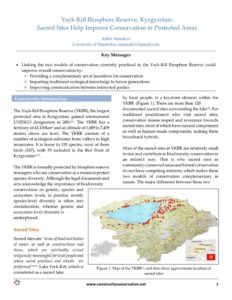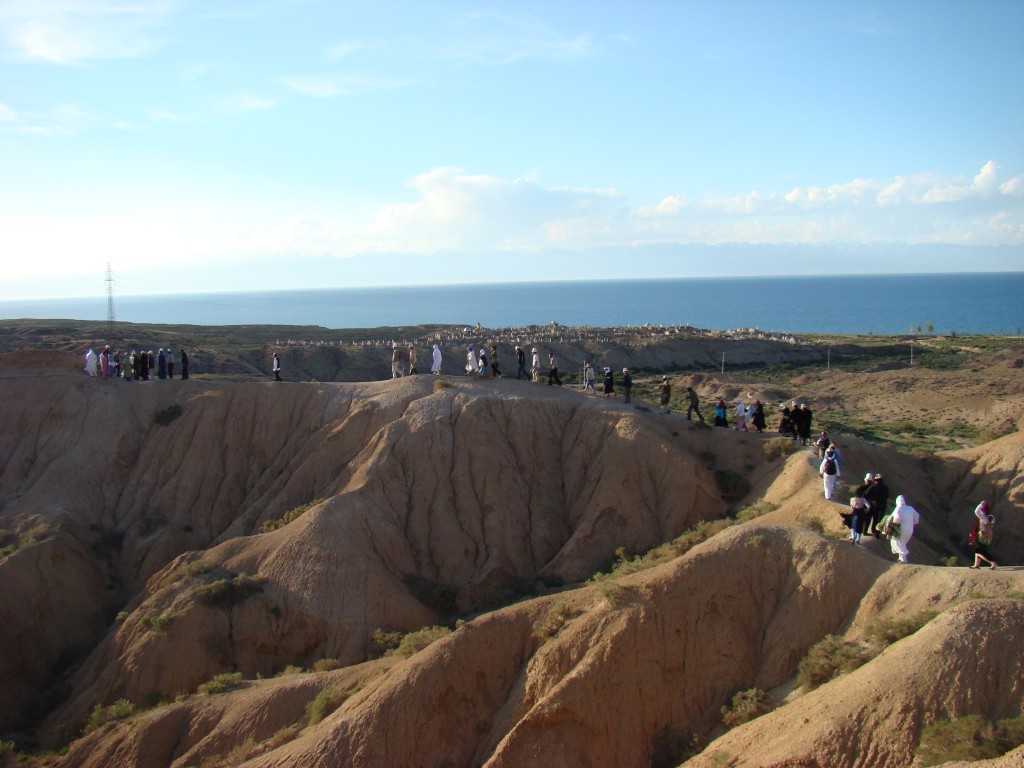
14 Dec Ysyk-Köl Biosphere Reserve, Kyrgyzstan
Aibek Samakov,University of Manitoba; aisamakov@gmail.com
Key Messages
Linking the two models of conservation currently practiced in the Ysyk-Köl Biosphere Reserve could improve overall conservation by:
- Providing a complementary set of incentives for conservation
- Imparting traditional ecological knowledge to future generations
- Improving communication between interested parties
Community Introduction
The Ysyk-Köl Biosphere Reserve (YKBR), the largest protected area in Kyrgyzstan, gained international UNESCO designation in 2001(1). The YKBR has a territory of 43,100km2 and an altitude of 1,609 to 7,439 meters above sea level. The YKBR consists of a number of ecological subzones from valleys to high mountains. It is home to 335 species, most of them birds (267), with 39 included in the Red Book of Kyrgyzstan(2,3).
The YKBR is formally protected by biosphere reserve managers who see conservation as a means to protect species diversity. Although the legal documents and acts acknowledge the importance of biodiversity conservation on genetic, species and ecosystem levels, in practice, mostly species-level diversity is taken into consideration, whereas genetic and ecosystem level diversity is
underplayed.
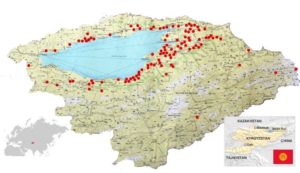
Figure 1. Map of the YKBR(6), red dots show approximate location of sacred sites
Sacred Sites
Sacred sites are “areas of land and bodies of water, as well as constructions and items, which are spiritually or/and religiously meaningful for local people and where sacral practices and rituals are performed”(4,5). Lake Ysyk-Köl, which is considered as a sacred lake by local people, is a keystone element within the YKBR (Figure 1). There are more than 120 documented sacred sites surrounding the lake(4). For traditional practitioners who visit sacred sites, conservation means respect and reverence towards sacred sites, most of which have natural components as well as human-made components, making them biocultural hybrids.
Most of the sacred sites in YKBR are relatively small in size and contribute to biodiversity conservation in an indirect way. That is why sacred sites as community-conserved areas and formal conservation do not have competing interests, which makes these two models of conservation complementary in nature. The major difference between these two models lies in their governance systems: on sacred sites governance is predominantly bottom-up and resemble institutions for managing commons(7), whereas the governance system of the YKBR, and the state reserves within it, is mostly top-down with little involvement of local communities in decision-making and management.
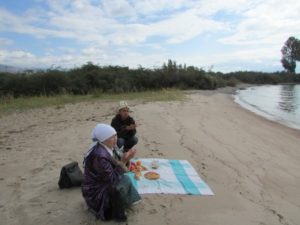
Figure 2. Manjyly-Ata Sacred Site (Photo Credit: Aigine Cultural Research Center)
Conservation and Livelihood Challenges
Community members, both male and female, feel that the conservation strategies in the YKBR have been largely ineffective due to:
• Lack of collaboration between local communities and biosphere reserve managers.
• Lack of community support for YKBR
conservation strategies and activities.
• Neglect of traditional ecological knowledge by biosphere reserve managers.
“We conduct a number of events such as cleaning up the shore of the lake, the March of Parks, round table meetings and discussions to raise local people’s ecological awareness. However, it seems like they [local people] forget everything we talked about during the event as soon as the event is over” – Male Biosphere Reserve employee.
“I wonder if the Biosphere Reserve [i.e. its employees] do any work. They know how to collect money, that’s it. They are supposed to protect nature from poachers but they are “number one” poachers themselves” -Local male from Ysyk- Köl area.
Many local people think that BR is an ecological check-point, where BR employees collect a fee for entering the YKBR. They do not know what kind of an institution the YKBR is, what its functions and goals are, what the BR does – Conservation manager(8) (Note: Ecological check-points were eliminated by Government Resolution May 23, 2013.) I see the sign that says that it is a Biosphere Reserve but I don’t know what exactly they do besides charging fees to tourists for entering the Ysyk-Köl. It is just another way of earning money, I guess. – Local villager(8)
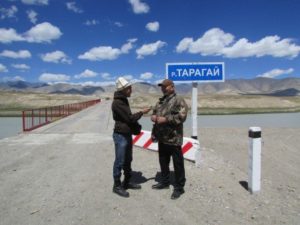
Figure 3. Interview with a YKBR ranger (Photo credit: Aibek Samakov)
Community Initiative
There is little interaction between sacred sites and the YKBR. At this point, sacred sites are not taken into account in formal conservation strategies and sacred site guardians are not trying to reach out to the YKBR. The lack of interaction between these two conservation models can be explained using the ‘path dependency concept’, where past policy and management decisions effect those in later stages(9).
The neglect of sacred sites can be explained by the fact that state-run institutions have always been reluctant to cooperate with spiritual/religious institutions. During the Soviet era, sacred sites in particular, and spirituality and religion in general, were oppressed, and since gaining independence the state has been secular. Thus, formal, state-run conservation has never paid attention to local, cultural (spiritual) mechanisms of conservation.
Local communities, on the other hand, have never received government support in managing their sacred sites. Moreover, during the Soviet era, sacred sites were preserved despite state sanctions against those who visited them(10). As a result, local communities have never relied on state support for managing sacred sites, even after gaining independence.
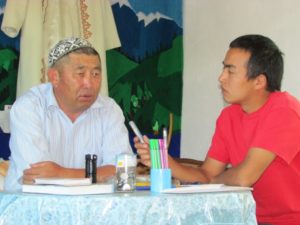
Figure 4. Interview with Sacred Site Guardian (Photo credit: Kairat Alibekov)
At the same time, in the last ten years, traditional practitioners, sacred site guardians, and NGOs such as Aigine have been active in promoting legal recognition of sacred sites in Kyrgyzstan. Thus, sacred sites and the YKBR co-exist on the same territory and frequently overlap. However, these two models of conservation do not interact and are not used to reinforce each other.
Practical Outcomes
Linking these two models of conservation could improve overall conservation in the YKBR by:
1. Making the concept of biosphere reserves more understandable for local communities.
2. Improving ecological monitoring.
3. Indirectly conserving species and areas.
4. Improving BR zoning.
5. Providing a complementary culture-rooted set of incentives for conservation (in addition to rational incentives).
6. Fostering a biocultural approach to conservation.
7. Collecting and using TEK in conservation.
8. Serving as a communication hub for YKBR managers and local communities.
9. Serving as a platform for local communities’ capacity building
Further Information
For more information regarding the content of this community story please see: Samakov A. 2015. Sacred sites: opportunity for improving biocultural conservation and governance in Ysyk-Köl Biosphere Reserve, Kyrgyz Republic. Thesis, University of Manitoba, Canada. Available for free at:
http://umanitoba.ca/institutes/natural_resources/pdf/theses/Samakov,%20Aibek.MNRM%202015.pdf
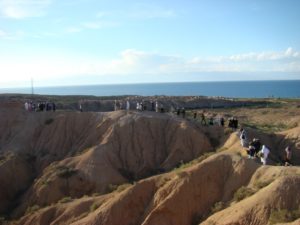
Figure 5. Manjyly-Ata Sacred Site (Photo Credit: Aigine Cultural Research Center)
References
1. UNESCO. 2012. Ecological Sciences for Sustainable Development. Issyk Kul. URL: http://www.unesco.org/ new/en/natural-sciences/environment/ecologicalsciences/ biosphere-reserves/asia-and-the-pacific/ kyrgyztan/issyk-kul/ Retrieved on April 16, 2014.
2. MAB. 2002. Biosphere Reserve Directory. Biosphere Reserve Information. Kyrgyzstan. Issuk-Kul. URL: http://goo.gl/16DYQi. (Accessed on May 15, 2015).
3. Ysyk-Köl Biosphere Reserve Statute. 2000. The Government of the Kyrgyz Republic. Signed on January 24, 2000. N 40.
4. Aitpaeva G. 2013. Sacred Sites of the Southern Kyrgyzstan: Nature, Manas, Islam. Aigine Cultural Research Center, Bishkek. Aitpaeva, G., Egemberdieva, A., & Toktogulova M. (2007). Mazar worship in Kyrgyzstan: rituals and practitioners in Talas. Aigine Cultural Research Center, Bishkek.
5. Wild R. & McLeod C. (Eds). 2008. Sacred Natural Sites: Guidelines for Protected Area Managers. IUCN, Gland, Switzerland.
6. Baetov. 2006. Source: www.unesco.org/mab/br/focus/2002Oct/Issyk.htm.
7. Rutte C. 2011. The sacred commons: conflicts and solutions of resource management in sacred natural sites. Biological Conservation, 144(10), 2387-2394.
8. Howlett M. 2003. Canadian environmental policy and the natural resources sector: paradoxical aspects of transition to a post-staples political economy. In: Lee, E., & Perl, A. (Eds.). (2003). The Integrity Gap: Canada’s Environmental Policy and Institutions. UBC Press.
9. Aitpaeva G., Egemberdieva A., & Toktogulova M. (Eds.). 2007. Mazar worship in Kyrgyzstan: rituals and practitioners in Talas. Aigine Cultural Research Center, Bishkek.
See below for the Kyrgyz language abstract for this community story, “Ысык-Көл биосфералык аймагы, Кыргызстан,Табигый коруктардагы жаратылышты сактоого касиеттүү жердердин кошкон салымы.”




